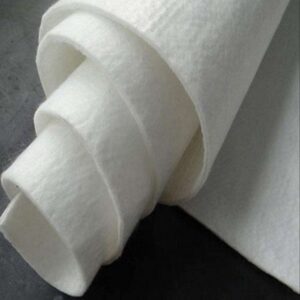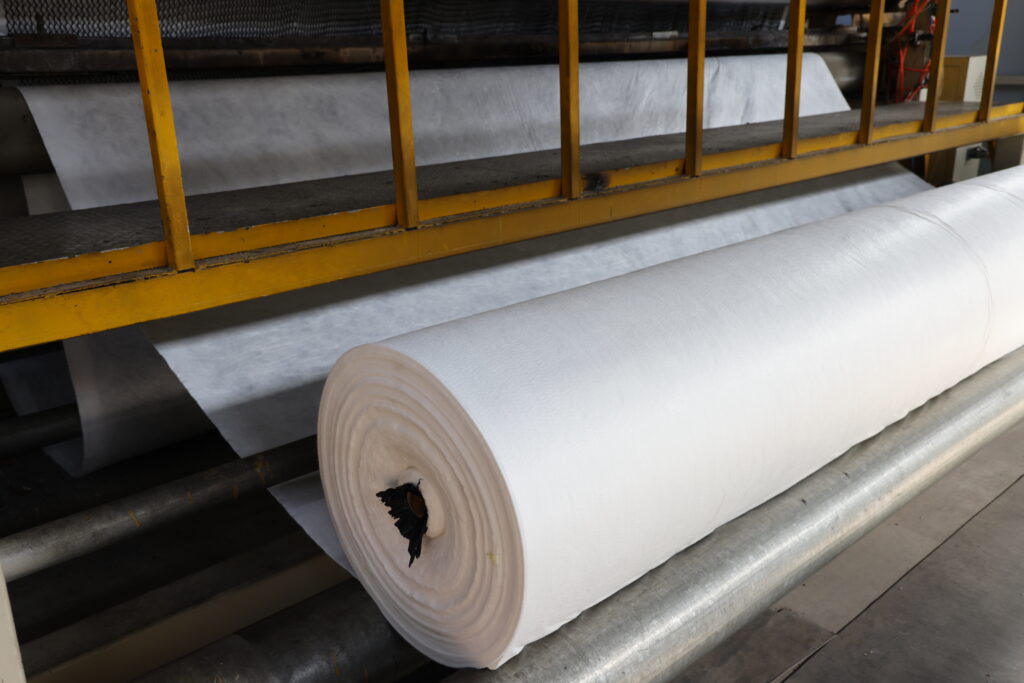What is geotextile?
Geotextile is an engineering material, usually a textile material made of synthetic fibers (such as polypropylene, polyester, polyethylene, etc.) or natural fibers (such as cotton or linen). Its main purpose is to be used in civil engineering, land management and environmental engineering to improve the performance of soil and foundations, control erosion, filter water flow, separate different layers of soil or materials, etc. Geotextiles are often referred to as “geotextiles” or “geontextiles.”
The following are the main uses and functions of geotextiles:
Separation and Reinforcement: Geotextiles can be used to separate different soil layers or materials to prevent them from mixing or crossing over. It can also be used to strengthen soil, increase its load-bearing capacity and reduce subsidence or settlement.
Filtration and Drainage: The open-pore structure of geotextiles allows water to pass through while preventing soil particles from being washed away. This helps control water flow, filter sewage, reduce soil erosion, and prevent soil particles from washing away beneath the foundation.
Protection: Geotextiles can be used to protect underground pipes, underground structures or land from external impact, pressure or chemicals.
Environmental protection: Geotextiles can be used in environmental projects, such as wetland restoration, water body protection, coastline protection, etc., to help control soil erosion, vegetation growth and ecosystem protection.
Soil stability: Geotextiles can be used to prevent soil erosion and land landslides, improve soil stability and sustainable land use.
Geotextiles generally come in different types, including nonwoven geotextiles and woven geotextiles. Non-woven geotextile is made by random arrangement and hot pressing of fibers, and has good filtering and separation capabilities. Woven geotextiles are made by weaving or weaving fibers and have high strength and durability.
Geotextiles are widely used in civil engineering, road construction, water conservancy projects, environmental protection and landscaping to improve soil and foundation performance and ensure project stability and environmental sustainability.

Which geotextile is the cheapest?
The price of geotextiles depends on several factors, including material type, quality, thickness, size, brand, market supply and demand, and geographical location. Generally speaking, nonwoven geotextiles are usually less expensive than woven geotextiles because they are usually less expensive to manufacture. However, the specific price will still vary depending on the above factors.
Here are some factors that may affect geotextile prices:
Material type: Different types of geotextiles, such as non-woven and woven geotextiles, have different performance characteristics and costs, with non-woven geotextiles generally being cheaper.
Thickness: Geotextile thickness is usually expressed in units of “oz” (ounces) or “gsm” (grams per square meter). Thinner geotextiles are generally less expensive, but may not be as durable as thicker geotextiles.
Size: The size and shape of the geotextile will affect the price. Custom-sized geotextiles may be more expensive.
Brand: Different manufacturers and brands of geotextiles may have different prices, and some well-known brands usually have higher prices.
Market supply and demand: Market supply and demand will affect price fluctuations. High demand and shortages can cause prices to rise, while low demand can cause prices to fall.
Geography: The price of geotextiles may vary in different regions, depending on factors such as transportation costs, taxes, and local market competition.
Quality and Certifications: Geotextiles with specific certifications, such as products that meet relevant standards, may be more expensive.
In conclusion, to find the cheapest geotextile, you can consider quotes from different suppliers and compare options of different materials, thicknesses and sizes. Also, make sure the geotextile you select meets the requirements of your specific project to avoid additional costs due to quality issues. Also remember that the quality and performance of geotextiles are often crucial in engineering projects, so consider not only price but also suitability and durability when selecting.
What geotextile has the best quality?
The quality of geotextiles is affected by many factors, so the “best” geotextile depends on the requirements and conditions of the specific project. Here are some key factors that affect the quality of geotextiles, so you can choose the right geotextile based on your project needs:
Material type: Geotextile is usually divided into nonwoven geotextile and woven geotextile. Typically, woven geotextiles perform better in terms of strength and durability, but nonwoven geotextiles perform better in filtration and separation. According to the specific requirements of the project, select the appropriate type of geotextile.
Tensile Strength: The tensile strength of geotextiles is very important, especially in projects that require separation and reinforcement. Higher tensile strength can improve the performance of geotextiles and increase their durability.
Chemical Resistance: If the geotextile will be exposed to chemically aggressive environments, such as acidic or alkaline soils, then chemical resistance is an important consideration.
Permeability Control: The permeability control capabilities of geotextiles are important to control moisture flow and prevent erosion. Select the appropriate permeability level to suit the project requirements.
Certifications and Standards: Ensure that geotextiles comply with relevant international or regional standards and certifications to ensure their quality and performance.
Thickness and Density: The thickness and density of a geotextile can also affect its performance. Thicker geotextiles are generally more durable but may not be suitable for all construction projects.
Brands and Manufacturers: Well-known brands usually offer higher quality geotextiles, but may also be more expensive. Choosing reputable manufacturers and suppliers is usually a wise choice.
Project Requirements: The final selection should be made based on the needs of the specific project, including project type, geological conditions, soil characteristics and required performance.
Taking these factors into consideration, the selection of the best geotextile should be evaluated on a case-by-case basis to ensure it can meet the performance and sustainability requirements of the project. The best geotextiles will perform well in the specific environment of the project and provide reliable support for the project. Therefore, detailed engineering analysis and material evaluation are required when selecting geotextiles.


垃圾处理场工-225x300.jpg)
